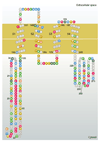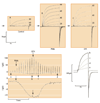Voltage-gated proton channels find their dream job managing the respiratory burst in phagocytes
- PMID: 20134026
- PMCID: PMC3023998
- DOI: 10.1152/physiol.00039.2009
Voltage-gated proton channels find their dream job managing the respiratory burst in phagocytes
Abstract
The voltage-gated proton channel bears surprising resemblance to the voltage-sensing domain (S1-S4) of other voltage-gated ion channels but is a dimer with two conduction pathways. The proton channel seems designed for efficient proton extrusion from cells. In phagocytes, it facilitates the production of reactive oxygen species by NADPH oxidase.
Figures




Similar articles
-
Pharmacology of voltage-gated proton channels.Curr Pharm Des. 2007;13(23):2400-20. doi: 10.2174/138161207781368675. Curr Pharm Des. 2007. PMID: 17692009 Review.
-
The intimate and mysterious relationship between proton channels and NADPH oxidase.FEBS Lett. 2009 Jan 5;583(1):7-12. doi: 10.1016/j.febslet.2008.12.005. Epub 2008 Dec 10. FEBS Lett. 2009. PMID: 19084015 Free PMC article.
-
The intimate and controversial relationship between voltage-gated proton channels and the phagocyte NADPH oxidase.Immunol Rev. 2016 Sep;273(1):194-218. doi: 10.1111/imr.12437. Immunol Rev. 2016. PMID: 27558336 Free PMC article. Review.
-
Voltage-gated proton channels.Compr Physiol. 2012 Apr;2(2):1355-85. doi: 10.1002/cphy.c100071. Compr Physiol. 2012. PMID: 23798303 Free PMC article. Review.
-
Interactions between NADPH oxidase and voltage-gated proton channels: why electron transport depends on proton transport.FEBS Lett. 2003 Nov 27;555(1):57-61. doi: 10.1016/s0014-5793(03)01103-7. FEBS Lett. 2003. PMID: 14630319 Review.
Cited by
-
The divergence, actions, roles, and relatives of sodium-coupled bicarbonate transporters.Physiol Rev. 2013 Apr;93(2):803-959. doi: 10.1152/physrev.00023.2012. Physiol Rev. 2013. PMID: 23589833 Free PMC article. Review.
-
pH regulation and beyond: unanticipated functions for the voltage-gated proton channel, HVCN1.Trends Cell Biol. 2011 Jan;21(1):20-8. doi: 10.1016/j.tcb.2010.09.006. Epub 2010 Oct 18. Trends Cell Biol. 2011. PMID: 20961760 Free PMC article. Review.
-
Subunit interactions during cooperative opening of voltage-gated proton channels.Neuron. 2013 Jan 23;77(2):288-98. doi: 10.1016/j.neuron.2012.12.021. Neuron. 2013. PMID: 23352165 Free PMC article.
-
Voltage and pH sensing by the voltage-gated proton channel, HV1.J R Soc Interface. 2018 Apr;15(141):20180108. doi: 10.1098/rsif.2018.0108. J R Soc Interface. 2018. PMID: 29643227 Free PMC article. Review.
-
The K+-H+ exchanger, nigericin, modulates taste cell pH and chorda tympani taste nerve responses to acidic stimuli.Chem Senses. 2011 May;36(4):375-88. doi: 10.1093/chemse/bjq146. Epub 2011 Jan 21. Chem Senses. 2011. PMID: 21257734 Free PMC article.
References
-
- Ädelroth P, Brzezinski P. Surface-mediated proton-transfer reactions in membrane-bound proteins. Biochim Biophys Acta. 2004;1655:102–115. - PubMed
-
- Aggarwal SK, MacKinnon R. Contribution of the S4 segment to gating charge in the Shaker K+ channel. Neuron. 1996;16:1169–1177. - PubMed
-
- Åkerfeldt KS, Lear JD, Wasserman ZR, Chung LA, DeGrado WF. Synthetic peptides as models for ion channel proteins. Acc Chem Res. 1993;26:191–197.
Publication types
MeSH terms
Substances
Grants and funding
LinkOut - more resources
Full Text Sources
Other Literature Sources
Molecular Biology Databases

